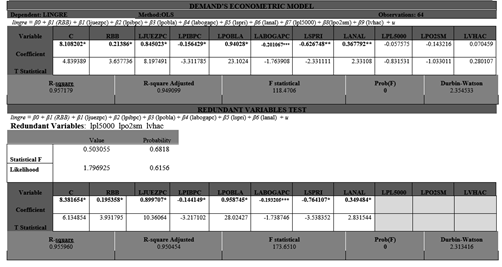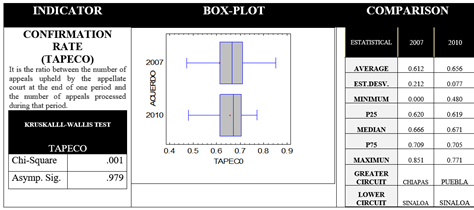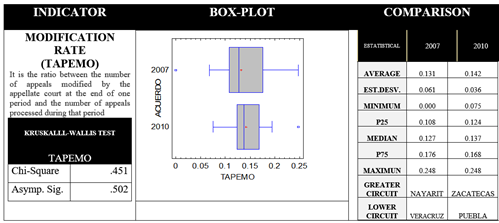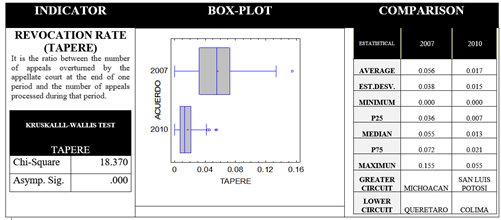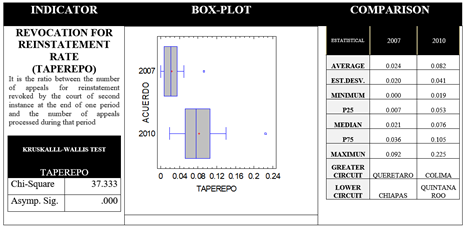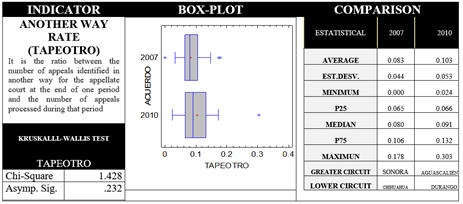1 INTRODUCTION
The administration of justice has different approaches. Particularly from the economic analysis of law and institutions the agents make their decisions to achieve certain goals and objectives that are guided in terms of incentives and social welfare produced, considering that changes in legal institutions are necessary where institutional constraints no longer produce the desired effect.
The evaluation of the performance of legal institutions is an essential tool to identify problems that arise in the judicial systems mainly because empirical investigations have confirmed the importance of this element for the economic development of the institutions. This document emphasizes the study of institutional performance and efficiency of justice through performance indicators to realize the reform of the judicial systems.
2 BACKGROUND
With the approval of the General Agreement 57/2006 of the Full Federal Judicial Council, it was determined the number and boundaries of the judicial circuits, territorial jurisdiction and specialization of the Judicial according to the Constitution of the United Mexican States and the Organic Law of the Judiciary. Within each circuit are established circuit courts and district courts. The Circuit Courts are of two kinds: Collegiate and Unitary. The first are integrated with three judges, while the latter have only one owner, like in the district courts.
Since 1994 there has been an increasing tendency for the number of courts set in Mexico. With the approval of the General Agreement 57/2006 of the Plenary Council of the Federal Judiciary on determining the number and boundaries of the circuits, the increment of courts has been sustained. In turn, the last major change is identified in the trend of 2007, which coincides with the introduction of the Results Based Budgeting (RBB) reform. In fact this has been reflected in the increment of circuit magistrates and district judges who are a vital part of the judicial system.
In order to identify inefficient judicial systems a variety of methodologies have been created to evaluate the performance as a key tool to identify the problems that arise in the judicial systems mainly because empirical investigations have confirmed the importance of the development of the institutions.
3 WORK PURPOSE
This paper centers the attention on the judicial circuits of the Judiciary. The purpose of this paper to analyze the performance of the judicial circuits as part of the Judiciary of the Federation of Mexico and determine whether the introduction of the Results Based Budgeting (RBB) reform influences the demand, supply and quality of justice following the hypotheses:
• The introduction of the Results Based Budgeting (RBB) reform affects the increase in the demand for justice and litigation in the judicial circuits established in Mexico.
• Factors such as the Results Based Budgeting (RBB) reform implementation, the number of judges and court workload are crucial in the supply of justice and its resolutions.
• One of the effects of introduction of the Results Based Budgeting (RBB) reform stems in the increased quality of decisions of the district courts of the judicial circuits.
The use of Box-Plot diagrams is fundamental to understand statistical changes after the introduction of the Results Based Budgeting (RBB) reform. The Ordinary Least Squares Regression will help us to identify the positive effect of the introduction of the Results Based Budgeting (RBB) reform about the demand and supply of the judicial circuits of Mexico. The Kruskall-Wallis test is crucial to identify the quality related to the implementation of the introduction of the Results Based Budgeting (RBB) reform. A brief explanation will be at first in Sect 4, after that a review of the literature is presented in Sect. 5. The Judicial Organization and Output is presented in Sect. 6, which includes a brief data description; in Sect. 7 offers the Analysis of Hypothesis Testing and the econometric models; and finally, the principal results and conclusions with some implications to judicial policy making that can be deduced from the empirical analysis made in this research.
4 RESULTS BASED BUDGETING (RBB) REFORM
The institutional design that governs the Results Based Budgeting (RBB) and the budget process in general, is found in the constitutional and legal reforms carried out, among them the issuance in 2006 of the Federal Budget and Fiscal Responsibility Law, the reform of the Constitution in matters of public spending and auditing, effective in 2008 and the consequent reforms to the aforementioned Law on the RBB.
The Federal Budget and Fiscal Responsibility Law established a new institutional design in budgetary matters that serves as a platform to launch a new budgetary order that gives greater legal and economic certainty, as well as transparency to the budget process as a whole. Likewise, it incorporated principles of fiscal responsibility to promote an economic policy that supports the development of the country based on sound public finances, the efficient, effective and transparent use of public resources and the rendering of accounts to the population regarding their management.
The judiciary took among other commitments, the installation on the new courts in circuits with higher workloads to help overcome the situation with public safety of the nation and to provide more flexible and efficient responses that allow deal with higher quality and with quick judicial processes. In 2008 the Article 134 of the Political Constitution Mexico establishes that the economic resources available to the Federation will be administered with efficiency, effectiveness, economy, transparency and honesty to satisfy the objectives for which they are destined, as well as a mandate in article 111 of the Federal Budget and Fiscal Responsibility Law, regarding that the system is mandatory for spending executors by monitoring and verifying compliance with the goals and government objectives set, as well as based on indicators, allow to know the social impact of the programs and projects carried out.
The Article 17 of the Constitution of Mexico, second paragraph, provides that the courts will be expeditious justice in the timing and terms established by law and issue its rulings in a prompt, thorough, impartial and free. In fact the importance of this is that the implementation of the agreement presents the notion of efficiency as a public policy within the judiciary. This is emphasized because too often, the judicial institutions have taken refuge behind the principle of the independence or the character of the service they provide to protect the analysis usually. Little attention is given to issues related to performance and accountability (Cabrillo and Fitzpatrick, 2011, p. 28), and in some cases there may be doubt as to the relationship between the structure of judicial councils and quality (Garoupa and Ginsburg, 2008, p. 33). Therefore attention on the quality and speed of judicial proceedings is intended to analyze the efficiency of the judiciary in the area of reform of judicial systems to involve significant allocation of material, human and economical resources.
5 LITERATURE REVIEW: SUPPLY, DEMAND AND QUALITY OF JUSTICE
From economic theory, the decision to demand justice responds to numerous incentives such as producing large institutional arrangements. Therefore emphasizes the fundamental objective of this work is to analyze empirically the effects, specifically in the performance of the judicial circuits that are part of the Judicial Branch Federation of the Mexican States and to determine the influence of the agreement on the demand, supply and quality of justice.
It is plausible to understand the performance improvement prospects of the courts that are part of the judiciary. That would imply that it is possible to obtain expectations of lower cost of litigation. Following the proposal, ceteris paribus, to higher profits and lower costs will generate incentives to litigate, interpreted in a larger number of cases filed in the courts and in deriving on a higher rate of litigation. In this regard we have reviewed the following documents in reference to understand the factors that influence this component:
TABLE 1: DEMAND DETERMINANTS
| Posner (1997) | Hanssen (1999) | Ginsburg & Hoetker (2006) | Yates, Tankersley & Brace (2010) |
| - Entry - Insurance - Urban Population - Population Density - Alcohol - Ratio between men and women - Liability insurance | - Population - Urbanization - Population Density - Education - Per capita income - Lawyers per capita - Number of judges per 1000 inhabitants | - Lawyers per capita - Number of judges per 1000 inhabitants - Reform in Civil Procedure - Per capita income | - Institutional Reforms - Population Density - Graduate Lawyers - Structural courts - Distribution of ideological preferences - Mechanisms for selecting judges |
On the supply side of justice generates the expectation, considering that the main objective of the RBB is to provide answers more agile and efficient that would allow more quality and speed in the judicial process, for that reason it would be expected an increment of the cases of the courts. In turn, the agreement involved installing new courts in circuits with higher workloads to help overcome the situation. The elements that determine the supply are mentioned in this table:
TABLE 2: SUPPLY DETERMINANTS
| Buscaglia & Ullen (1997) | Buscaglia & Dakolias (1999) | Cabrillo & Pastor (2001) | Rosales- López (2008) |
| - New judged - Incentives to litigate - Factors incidents in Administration of Justice | - Capital - Budget - Technology - Judicial Activism - Cost per case | - Organizational Issues - Socialization and Training of preferences (judiciary) | - Judicial Staff - Rotation - Cessation - Judge Vacancies |
For the quality item, it would be expected an improvement in the quality of the judicial proceedings, so there are new standards that facilitate knowledge objectives, assessment and where appropriate, proposals and improvements to better administration of justice. For this link takes up the notion to understand that quality is a goal internalized by the vast majority of judges while efficiency is a concept that causes controversy in this area, so the challenge is to make judges internalize the efficient use of resources, as well as other values such as ethics, that can actually produce more and better justice without increased resources (Rosales-Lopez, 2005, p. 18).
6 JUDICIAL ORGANIZATION AND OUTPUT
The Judicial Council has maintained its preeminence over the other components of the judiciary, this is because as established in Articles 68 and 81, section II and VI, of the Organic Law of the Judicial Power of the Federation, the Federal Judicial Council is the body responsible for the administration, supervision, discipline and judicial career in circuit courts and district courts, regardless of technical, managerial and to issue its resolutions, in addition, has the authority to issue general agreements that allow the proper performance of their duties. The Judicial Council brings together the operation of all courts except the Supreme Court and the Federal Electoral Tribunal.
There are 32 judicial circuits in the Federal Judiciary. Within each circuit are established circuit courts and district courts. The Circuit Courts are of two kinds: Collegiate2 and Unitary3. The first are integrated with three judges, while the latter have only one owner, like the district courts4.
During the years studied (2007-2010) there was a general upward trend of the issues resolved in the courts of the judiciary. Elements such as the initial stock, input, workload and output have grown over time. In 2007 there is a noticeable change to the number of courts, we can further understand the trend in the growing movement of matters discussed in the judiciary.
7 HYPOTHESIS TESTING
The analysis will involve the following hypothesis contrasts:
TABLE 3: HYPOTHESIS TESTING
| RBB | HYPOTHESIS 1 | HYPOTHESIS 2 | HYPOTHESIS 3 |
| EXPECTED EFFECT | INCREASE OF THE LITIGATION AND DEMAND OF JUSTICE | INCREASE OF THE RESOLUTION AND SUPPLY OF JUSTICE | INCREASE OF THE QUALITY IN THE RESOLUTIONS OF THE DISTRICT COURTS |
| KRUSKALLL WALLIS TEST | H0: θa ≠ θd Ha: θa = θd 95% confidence Ho is accepted | H0: θa ≠ θd Ha: θa = θd 95% confidence Ho is accepted | H0: θa ≠ θd Ha: θa = θd 95% confidence Ho is accepted |
| OLS REGRESION | H0: β1 > 0 Ha: β1 = 0 95% confidence Ho is accepted | H0: β1 >0 Ha: β1 =0 95% confidence Ho is accepted |
7.1 Litigation and Demand
Following the proposal, ceteris paribus, to higher profits and lower costs generated incentives to litigate, interpreted in a larger number of cases filed in the courts and in deriving a higher rate of litigation. To do this, we will conduct a hypothesis test using the Kruskall Wallis and the estimation of a multiple regression model by Ordinary Least Squares (OLS).
The Kruskall-Wallis test helps us to test the null hypothesis (Ho) and it states that the median litigation before the entry into force of RBB is different than the median litigation after the entry into force of the RBB. According to that we have the following results:
After this we will check hypotheses referring to the OLS models. To do this we need to identify key aspects for the proper functioning of the judicial demand mainly because demand is also a source of congestion, mainly because every year goes to court a lot of issues and in turn result in an induced demand for professionals (Rosales, 2005:3). We will test the following model:
TABLE 5: ECONOMETRIC MODELS
| DEMAND MODEL | LITIGATION MODEL | ||
|---|---|---|---|
| lingre = β0 + β1 (RBB) + β1 (ljuezpc) + β2 (lpibpc) + β3 (lpobla) + β4 (labogapc) + β5 (lspri) + β6 (lanal) + β7 (lpl5000) + β8(lpo2sm) + β9 (lvhac) + u | llitigation = β0 + β1 (RBB) + β1 (ljuezpc) + β2 (lpibpc) + β3 (labogapc) + β4 (lspri) + β5 (lanal) + β6 (lpl5000) + β7(lpo2sm) + β8 (lvhac) + u | ||
| VARIABLE | DESCRIPTION | SOURCE OF INFORMATION | |
| DEPENDIENT VARIABLES | |||
| LOG(INGRE) | Logarithm of the number of cases filed in the courts of the judiciary. By Judicial Circuit | Consejo de la Judicatura Federal | |
| LOG(LITIGATION) | Logarithm of cases filed in the courts of the judiciary by the population and multiplied by 100,000. By Judicial Circuit. | Consejo de la Judicatura Federal y del Consejo Nacional de Población. | |
| INDEPENDENT VARIABLES | |||
| RBB | Dichotomous variable. Where, RBB = 0 (year 2007 before the entry into force of the RBB) and RBB = 1 (year 2010 afterthe entry into force of RBB). | Consejo de la Judicatura Federal. | |
| LJUEZPC | Logarithm number of judges per capita. By Judicial Circuit. | Consejo de la Judicatura Federal y del Consejo Nacional de Población. | |
| LPIBPC | Logarithm of the number of per capita GDP at current prices. By Judicial Circuit. | INEGI y Consejo Nacional de Población. | |
| LPOBLA | Logarithm of the number of population. By Judicial Circuit. This variable applies only to the demand model. | INEGI y Consejo Nacional de Población. | |
| LABOGAPC | Logarithm of the number of practicing lawyers per capita. By Judicial Circuit. | INEGI, la Encuesta Nacional de Ocupación y Empleo (ENOE) y Observatorio Laboral de la Secretaría del Trabajo y Previsión Social | |
| LSPRI | Logarithm of % Population 15 years or more without complete primary | Consejo de la Judicatura Federal y del Consejo Nacional de Población. | |
| LANAL | Log of % Population with 15 years or more illiterate | Consejo de la Judicatura Federal y del Consejo Nacional de Población. | |
| LPL5000 | Log of % Population in towns with less than 5000 inhabitants. By Judicial Circuit. | Consejo de la Judicatura Federal y del Consejo Nacional de Población. | |
| LPO2SM | Log of % Employed population with income up to two minimum wages | Consejo de la Judicatura Federal y del Consejo Nacional de Población. | |
| LVHAC | Log of % Homes with some level of overcrowding | Consejo de la Judicatura Federal y del Consejo Nacional de Población. | |
Regarding the interpretation of the model, we will focus the coefficient β1 as we expect the number of cases filed and the litigation by Judicial Circuit increase after the entry of RBB.
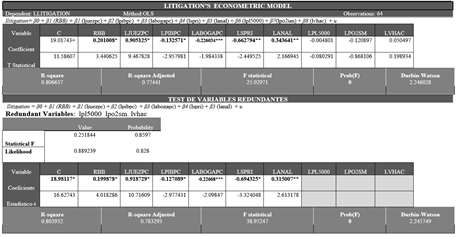
Note: The coefficients highlighted in bold are the ones for this regression were significant: (*) Significant for α = 0.01. (**) Significant for α = 0.03. (***) Significant for α = 0.09.
TABLE 6 ECONOMETRIC MODEL OF DEMAND
We can interpret the model of determinants of demand where we used the method of ordinary least squares estimation5. We can infer6 that the variable RBB is significant and positive7 and the statistical probabilities in such a way that is relevant for a significance level α = 0.05. RBB is accepted for the null hypothesis that the coefficient is significant for the regression analysis, however confirmed multicollinearity between variables as LPL5000, LCHAC LPO2SM since they are not significant. Thus we proceed to perform the redundancy test8 which cleans the respective variables form the model. With this we can conclude that the explanatory power of the new model is better than the last if redundant variables are eliminated, proving thereby that the variables of the equation are individually significant reflected in a coefficient of determination greater than the original model9, thereby confirming that we are not omitting any important variable. If we take the estimate of β1, we can say that, all else equal, the entry into force of RBB has led to an increased demand in number of cases filed, an increase of 19.53% in the number of cases filed by Judicial Circuit courts. Now we will see the main results of litigation model:

Note: The coefficients highlighted in bold are the ones for this regression were significant: (*) Significant for α = 0.01. (**) Significant for α = 0.03. (***) Significant for α = 0.06.
TABLE 7 ECONOMETRIC MODEL OF LITIGATION
The model of determinants of litigation was conducted by the method of least squares estimation. Given the relevant information10 can be inferred11 that the variable RBB is significant and positive12 for a significance level α = 0.05. We accept for RBB the null hypothesis that the coefficient is significant for the regression analysis, however confirmed as in the previous model, the multicollinearity between variables as LPL5000, LCHAC LPO2SM and they are not significant. The redundancy test13 removes the variables and concludes that the explanatory power of the new model is better than the last if redundant variables are eliminated, proving thereby that the variables of the equation are individually significant in a coefficient reflecting greater than the resulting determination of the original model14, thereby confirming that there are no important variables excluded in the model. Taking the estimate of β1, we can say that RBB has led to an increased demand in number of cases filed per thousand population of 20% increase in the number of cases filed by Judicial Circuit courts from further competition. Here are the relevant checks to the supply.
7.2 Supply and Resolution
The expectation is generated, under which the main objective is to provide answers RBB more agile and efficient expected an increase in the number of alumni affairs by the courts. The RBB involved installing new courts in circuits with higher workloads to help overcome the situation. The Kruskall-Wallis test help us to test the null hypothesis (Ho) and it states that the median litigation before the entry into force of RBB is different than the median litigation after the entry into force of the RBB. According to that we have the following results:
Now we will test hypotheses referring to the OLS models. To do this we need to identify key aspects of the supply of legal protection as the "production of justice" is a task "labor-intensive" and in this sense, empirical evidence shows that the legal output depends on variables such as the number of staff working in the courts, the availability of additional staff in the courts, the educational level of the judges, the prospects for promotion of judges and staff management, time devoted to tasks judges award and administrative tasks (Garcia and Rosales, 2010:9) plus a further problem arises from the fact that the judiciary can be seen as a process of socialization and training preferences (Cabrillo and Pastor, 2001: 79-80).
From this perspective and based on the factors identified in the research hypotheses, we proceed to estimate the multiple linear regression models using the OLS technique to assess the effect on resolution and supply of justice. In this regard the following models are shown:
TABLE 9 ECONOMETRIC MODELS
| SUPPLY MODEL | RESOLUTION MODEL | ||
|---|---|---|---|
| legre= β0 + β1 (RBB) + β2 (lnumjue) + β3 (lcargajuris) + u | lresol = β0 + β1 (RBB) + β2 (lnumjue) + β3 (lcargajuris) + u | ||
| VARIABLE | DESCRIPTION | SOURCE OF INFORMATION | |
| DEPENDIENT VARIABLES | |||
| LOG(EGRE) | Logarithm of the number of output cases in the courts of the judiciary. By Judicial Circuit | Consejo de la Judicatura Federal | |
| LOG(RESOL) | Logarithm of the rate of resolution of the number of cases decided in the courts of the judiciary by the population and multiplied by 100,000. By Judicial Circuit | Consejo de la Judicatura Federal y Consejo Nacional de Población.. | |
| INDEPENDENT VARIABLES | |||
| RBB | Dichotomous variable. Where, RBB = 0 (year 2007 before the entry into force of the RBB) and RBB = 1 (year 2010 after the entry into force of RBB). | Consejo de la Judicatura Federal. | |
| LNUMJUE | Logarithm number of judges who work in the courts. By Judicial Circuit. | Consejo de la Judicatura Federal. | |
| LCARGAJURIS | Logarithm of court workload working in the courts. Which means the number of cases pending at the beginning + the number of cases filed divided by the number of courts. By Judicial Circuit. | Consejo de la Judicatura Federal | |
Regarding the interpretation of the model, we will focus the coefficient β1 as we expect an increment in the number of cases and resolution by the Judicial Circuits after the implementation of RBB. Below are the results of the models:
TABLE 10: ECONOMETRIC MODEL OF SUPPLY
| SUPPLY’S ECONOMETRIC MODEL | |||||||
|---|---|---|---|---|---|---|---|
| Dependent: LEGRE | Method: OLS | Observations: 64 | |||||
| legre = β0 + β1 (RBB) + β2 (lnumjue) + β3 (lcargajuris) + u | |||||||
| Variable | C | RBB | LNUMJUE | LCARGAJURIS | |||
| Coefficient | 1.887781* | 0.065443*** | 0.931603* | 0.686259* | |||
| T Statistical | 3.189269 | 1.818917 | 46.97363 | 8.744107 | |||
| R-square | R-square Adjusted | F statistical | Prob(F) | Durbin-Watson | |||
| 0.974292 | 0.973007 | 757.9659 | 0 | 1.790325 | |||
Note: The coefficients highlighted in bold are the ones for this regression were significant: (*) Significant for α = 0.01. (**) Significant for α = 0.03. (***) Significant for α = 0.07
With the estimation of least squares estimation15 it can be inferred that the variable RBB is significant and positive16 with significance level α = 0.05. Also RBB is important for the null hypothesis that the coefficient is significant for the regression analysis and it can be conclude the explanatory power of the model, proving thereby that the variables in the equation are individually significant reflected in a coefficient of determination high as a whole17, thus confirming the importance of the model. If we take the estimate of β1, we can say that, ceteris paribus, there is an increment in supply in number of cases filed of 6.54%. Now we will see the main results of the model for resolution:
TABLE 11: ECONOMETRIC MODEL OF RESOLUTION
| RESOLUTION ECONOMETRIC MODEL | ||||||
|---|---|---|---|---|---|---|
| Dependent: LRESOL | Method:OLS | Observations: 64 | ||||
| lresol = β0 + β1 (RBB) + β2 (lnumjue) + β3 (lcargajuris) + u | ||||||
| Variable | C | RBB | LNUMJUE | LCARGAJURIS | ||
| Coefficient | 2.71499* | 0.175267*** | 0.167672* | 0.438201** | ||
| T Statistical | 1.754459 | 1.863295 | 3.233852 | 2.135679 | ||
| R-square | R-square Adjusted | F statistical | Prob(F) | Durbin-Watson | ||
| 0.25544 | 0.218212 | 6.861509 | 0 | 2.552739 | ||
Note: The coefficients highlighted in bold are the ones for this regression were significant: (*) Significant for α = 0.01. (**) Significant for α = 0.03. (***) Significant for α = 0.07
To understand the determinants in the estimation18 we can infer that the variable RBB is significant, positive19 and the statistical probabilities with significance level α = 0.05. Also RBB is important for the null hypothesis that the coefficient is significant for the regression analysis and it can be concluded that the explanatory power of the model significant as a whole20. If we take the estimate of β1, we can say that, all else equal, the entry into force of RBB has caused an increase of 17% in resolution by Judicial Circuit.
7.3 Quality of Justice
Retaking the quality item, one would expect an improvement in the quality of the judicial proceedings. The joint search for quality and production efficiency of justice results in greater welfare for society. Quality is an objective internalized by the vast majority of judges while efficiency is a concept that causes controversy in this area, so the challenge is to make judges internalize the efficient use of resources, as other values such as ethics that can actually produce more and better justice without increased resources (Rosales-Lopez, 2005:18)
To evaluate which has been the impact on the quality five indicators have been used regarding the rate of appeals in the District Courts Judicial Circuit in Mexico. If the quality of judgments in first instance has increased, it is expected that the appeal rate has decreased. To do this we apply the Kruskall-Wallis test allowing test the following hypothesis is corroborated:
With Kruskall-Wallis test it was found that there is no significant difference between the median rate of appeals confirmed before and after RBB. So after RBB has been a marginal increase of about in the confirmation rate of appeals against decisions of the district courts. The implementation of the RBB has not proved significant changes in confirming resolutions. We can identify a change about judicial circuits with the lowest rate Now we will see the following case of appeal:
Following the completion of the Kruskall-Wallis test there is no significant difference between the median rate of appeals modified before and after RBB. So after the entry into force of RBB has been a marginal increase in the rate of appeals against decisions by the district courts. It has not proved significant changes presented in resolutions. Regarding judicial circuits may see a change from those who hold the highest rate of change and with the lowest rate with the years referenced. Then the next case of appeal:
Here the change becomes visible for the quality on the resolutions. There is a significant difference between the median rate of appeals modified before and after RBB. So after the RBB there has been a significant decrease in the rate of withdrawal of appeals against decisions by the district courts. By this we can say that the RBB has proved to be significant in terms of the changes presented in the revocation of resolutions. Consider now the penultimate appeal:
We have found significant difference between the median rate of appeals revoked for replacement procedure before and after RBB. Following RBB, there has been a significant increase in the rate of revocation for replacement procedure appeals against decisions by the district courts. By this we can say that the RBB has been significant in terms of the changes presented in the revocation procedure for replacement of the resolutions. Finally the following:
With the Kruskall-Wallis it can be seen that there is no significant difference between the median rate of appeals of another way and after RBB. Therefore it is the same as the first two case studies where the effect of RBB in quality of justice has been marginal in the rate of change for the district courts. Summarizing the hypothesis tests we can say that the RBB has had an ambiguous effect on the quality but relevant resolutions.
7.4 RESULT THE SUMMARY OF THE RESULTS, INDICATORS AND METHODS ARE SHOWN BELOW:
TABLE 17: PRINCIPAL RESULTS
| RBB | HYPOTHESIS 1 | HYPOTHESIS 2 | HYPOTHESIS 3 |
| EXPECTED EFFECT | ( INCREASE OF THE LITIGATION AND DEMAND OF JUSTICE | ( INCREASE OF THE RESOLUTION AND OFFERT OF JUSTICE | ( PARTIAL INCREASE OF THE QUALITY IN THE RESOLUTIONS OF THE DISTRICT COURTS |
| KRUSKALLL WALLIS TEST | ( H0: θa ≠ θd Ha: θa = θd 95% confidence Ho is accepted | (H0: θa ≠ θd Ha: θa = θd 95% confidence Ho is accepted | H0: θa ≠ θd Ha: θa = θd 95% confidence Ho is accepted |
| OLS REGRESION | ( H0: β1 > 0 Ha: β1 = 0 95% confidence Ho is accepted | ( H0: β1 >0 Ha: β1 =0 95% confidence Ho is accepted | |
| RESULTS OF KRUSKALLL WALLIS TEST | LITIGATION: H0: θa ≠ θd ( 179 more cases per thousand inhabitants | RESOLUTION: H0: θa ≠ θd (210 more cases per thousand inhabitants | *TAPECO: Ha: θa = θd Remains Relatively Unchanged ( *TAPEMO: Ha: θa = θd Remains Relatively Unchanged ( *TAPERE: H0:θa≠θd (Decrease of Revocation *TAPEREPO:H0:θa≠θd (Increase of Revocation for replacement procedure *TAPEOTRO:Ha:θa=θd Remains Relatively Unchanged ( |
| RESULTS OF OLS REGRESSION | LITIGATION: ( H0: β1 > 0 Increment (20% (ceteris paribus) INPUT ( H0: β1 > 0 Increment (19.53% (ceteris paribus) | RESOLUTION: ( H0: β1 > 0 Increment (17%* (ceteris paribus) OUTPUT ( H0: β1 > 0 Increment (6.54% (ceteris paribus) |
The main effects of the introduction of the Results Based Budgeting (RBB) in aggregate can be summarized in:
• Regarding Input performance indicators: There is an increase in litigation in which is coupled the increased number of judges in office. This undoubtedly is related where increased workload as increased demand for justice.
• In reference to Output performance indicators: There is an increase in resolution and independence but paradoxically linked to increased independence, delay, delay mean and congestion.
• Increased demand and litigation. This result is possibly derived from the expectations of improving of performance of the courts that are part of the judiciary.
• Increased supply and resolution. Result of the increase of courts in the judicial circuits.
• A relative quality improvement. As a result of other factors, is strong confirmation rate, the rate of change and the rate of appeal in other respects had hardly any significant change. At the same time there was an increase in the rate of appeal for reinstatement and a reduction in the event of cancellation of orders. This is certainly a result of increased supply and demand, causing in turn an increase in workload and possibly greater margin of error impacting to maintain quality standards in the period prior to RBB.
8 CONCLUSIONS
This document has made an approach to the issue of performance evaluation, which is very important because it allows us to understand the different elements that are part of the economy of justice such as supply, demand and quality of the Judicial Justice in Mexico. The empirical analysis, baked by statistical information of the Judiciary of Mexico, indicates that the RBB has influenced the supply and demand of the judicial circuits but the influence in terms of quality cannot be completely conclusive.
These elements reveal whether institutional changes such as the implementation of the Results Based Budgeting (RBB) impacts the performance of the courts of the Mexican judiciary. In fact when comparing the years proposed is compelling to conclude that there was an increase in the movement of cases registered and therefore it can inferred the existence of an increase in demand and supply of justice court. To answer our research questions in general we can not conclusively say that the RBB has improved the performance of the judicial circuits.
However following the beginning proposal, ceteris paribus, higher profits and lower costs generated incentives to litigate, interpreted in a larger number of cases filed in the courts and it has derived in a higher rate of litigation. Hence it can be conclude about our second hypothesis that it can be found an increase in demand and litigation in the judicial circuits evaluated. In turn the supply side of justice, it has been showed an increase in the number of cases, an increase in supply and the resolution by the courts. This is derived from the installing of new courts in circuits with higher workloads.
Regarding the quality element related to the implementation of the RBB, the relationship was not as evident so that, in some cases we can not be conclusively to answer the research questions that infer that the increment of supply and demand of justice is reflected in the increase quality of judicial protection of the courts. This is because sometimes a higher input and output of cases can increase the margin of error despite efforts to train there a better way to judges and magistrates.
In reference to our last hypothesis is overwhelming that the confirmation rate, the rate of change and the rate of appeal in other respects had hardly any significant change under the reported years for this research. This was clearly an increase in the rate of appeal for reinstatement of the case and a reduction in the event of cancellation of orders. However in order to have more certainty, it is necessary to check the direction of the data specifically addressed in these cases and the limitations of the research leaves open the option for future opportunities.
It is important to do not forget that the reality of the issues raised in the Circuit Court of the Judiciary is very complex and we could not detach anything that involves performance assessment completely, however the important point is to analyze institutional changes such as the implementation of the RBB for a better understanding of the judicial function in Mexico.














